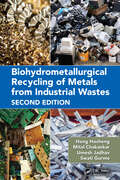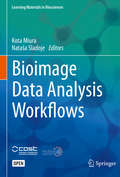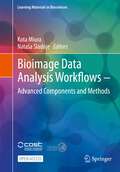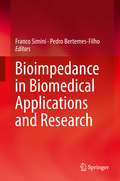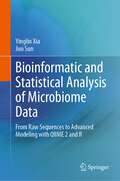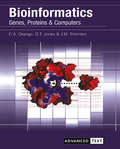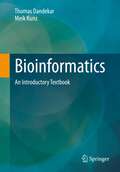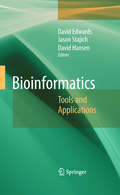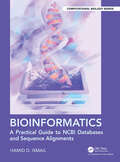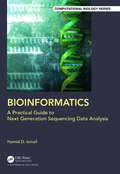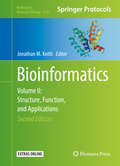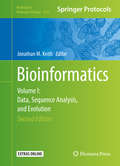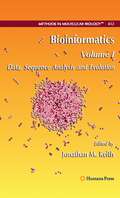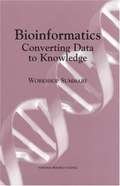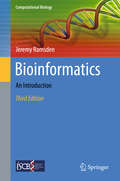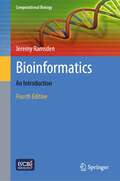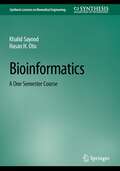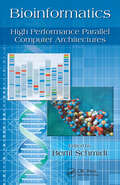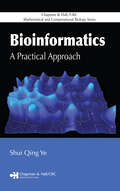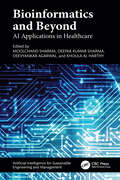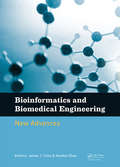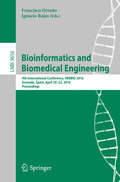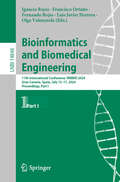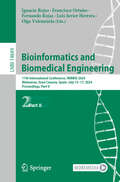- Table View
- List View
Biohydrometallurgical Recycling of Metals from Industrial Wastes
by Hong Hocheng Mital Chakankar Umesh Jadhav Swati GurmeAlthough many available metal recycling methods are simple and fast, they are also expensive and cause environmental pollution. Biohydrometallurgical processing of metals offers an alternative to overcome these issues, as the use of biological means not only helps to conserve dwindling ore resources but also fulfills the unambiguous need to extract metals in nonpolluting, low-energy, and low-cost way. This book covers biohydrometallurgy and its application in the recovery of metals from secondary sources like wastes. Fully updated for a new edition, it provides readers with a comprehensive overview of different wastes for metal recovery and biological treatment methods that are both environmentally friendly and economically viable. Offers a detailed explanation about generation of different metals containing industrial waste Explains traditional and new biological methods of recycling Reflects research advances across different industrial waste sources including electric vehicle batteries and LCDs from computers and other devices Focuses on each waste type and explores in detail the biohydrometallurgical recovery of metals from that waste Discusses fundamental microbial studies in bioleaching and updates about the use of emerging technologies and integrated techniques with different methods in combination for metal recovery Features a new chapter on techniques for metal extraction from bioleachate This book serves as an essential resource for researchers and professional engineers working in chemical and environmental engineering and biotechnology.
Bioimage Data Analysis Workflows (Learning Materials in Biosciences)
by Kota Miura Nataša SladojeThis Open Access textbook provides students and researchers in the life sciences with essential practical information on how to quantitatively analyze data images. It refrains from focusing on theory, and instead uses practical examples and step-by step protocols to familiarize readers with the most commonly used image processing and analysis platforms such as ImageJ, MatLab and Python. Besides gaining knowhow on algorithm usage, readers will learn how to create an analysis pipeline by scripting language; these skills are important in order to document reproducible image analysis workflows. The textbook is chiefly intended for advanced undergraduates in the life sciences and biomedicine without a theoretical background in data analysis, as well as for postdocs, staff scientists and faculty members who need to perform regular quantitative analyses of microscopy images.
Bioimage Data Analysis Workflows ‒ Advanced Components and Methods (Learning Materials in Biosciences)
by Kota Miura Nataša SladojeThis open access textbook aims at providing detailed explanations on how to design and construct image analysis workflows to successfully conduct bioimage analysis. Addressing the main challenges in image data analysis, where acquisition by powerful imaging devices results in very large amounts of collected image data, the book discusses techniques relying on batch and GPU programming, as well as on powerful deep learning-based algorithms. In addition, downstream data processing techniques are introduced, such as Python libraries for data organization, plotting, and visualizations. Finally, by studying the way individual unique ideas are implemented in the workflows, readers are carefully guided through how the parameters driving biological systems are revealed by analyzing image data. These studies include segmentation of plant tissue epidermis, analysis of the spatial pattern of the eye development in fruit flies, and the analysis of collective cell migration dynamics. The presented content extends the Bioimage Data Analysis Workflows textbook (Miura, Sladoje, 2020), published in this same series, with new contributions and advanced material, while preserving the well-appreciated pedagogical approach adopted and promoted during the training schools for bioimage analysis organized within NEUBIAS – the Network of European Bioimage Analysts. This textbook is intended for advanced students in various fields of the life sciences and biomedicine, as well as staff scientists and faculty members who conduct regular quantitative analyses of microscopy images.
Bioimpedance in Biomedical Applications and Research
by Franco Simini Pedro Bertemes-FilhoThis book is based on the best contributions to the advancement of bioimpedance knowledge and use from the Latin American Congress series, CLABIO. Basic bioimpedance facts as well as promising and original contributions to bioimpedance theory and applications are presented, giving the reader stimulating material for reflection, decision making, and further experiments. Contributions come from a diverse international pool of experts and address topics on electrode and skin impedance modelling, tomography, spectroscopy, instrumentation, and clinical applications.
Bioinformatic and Statistical Analysis of Microbiome Data: From Raw Sequences to Advanced Modeling with QIIME 2 and R
by Jun Sun Yinglin XiaThis unique book addresses the bioinformatic and statistical modelling and also the analysis of microbiome data using cutting-edge QIIME 2 and R software. It covers core analysis topics in both bioinformatics and statistics, which provides a complete workflow for microbiome data analysis: from raw sequencing reads to community analysis and statistical hypothesis testing. It includes real-world data from the authors’ research and from the public domain, and discusses the implementation of QIIME 2 and R for data analysis step-by-step. The data as well as QIIME 2 and R computer programs are publicly available, allowing readers to replicate the model development and data analysis presented in each chapter so that these new methods can be readily applied in their own research. Bioinformatic and Statistical Analysis of Microbiome Data is an ideal book for advanced graduate students and researchers in the clinical, biomedical, agricultural, and environmental fields, as well as those studying bioinformatics, statistics, and big data analysis.
Bioinformatics: A Practical Guide To The Analysis Of Genes And Proteins (Methods Of Biochemical Analysis Ser. #145)
by Andreas D. Baxevanis Gary D. Bader David S. WishartPraise for the third edition of Bioinformatics “This book is a gem to read and use in practice.” —Briefings in Bioinformatics "This volume has a distinctive, special value as it offers an unrivalled level of details and unique expert insights from the leading computational biologists, including the very creators of popular bioinformatics tools." —ChemBioChem “A valuable survey of this fascinating field. . . I found it to be the most useful book on bioinformatics that I have seen and recommend it very highly.” —American Society for Microbiology News “This should be on the bookshelf of every molecular biologist.” —The Quarterly Review of Biology The field of bioinformatics is advancing at a remarkable rate. With the development of new analytical techniques that make use of the latest advances in machine learning and data science, today’s biologists are gaining fantastic new insights into the natural world’s most complex systems. These rapidly progressing innovations can, however, be difficult to keep pace with. The expanded fourth edition of the best-selling Bioinformatics aims to remedy this by providing students and professionals alike with a comprehensive survey of the current field. Revised to reflect recent advances in computational biology, it offers practical instruction on the gathering, analysis, and interpretation of data, as well as explanations of the most powerful algorithms presently used for biological discovery. Bioinformatics, Fourth Edition offers the most readable, up-to-date, and thorough introduction to the field for biologists at all levels, covering both key concepts that have stood the test of time and the new and important developments driving this fast-moving discipline forwards. This new edition features: New chapters on metabolomics, population genetics, metagenomics and microbial community analysis, and translational bioinformatics A thorough treatment of statistical methods as applied to biological data Special topic boxes and appendices highlighting experimental strategies and advanced concepts Annotated reference lists, comprehensive lists of relevant web resources, and an extensive glossary of commonly used terms in bioinformatics, genomics, and proteomics Bioinformatics is an indispensable companion for researchers, instructors, and students of all levels in molecular biology and computational biology, as well as investigators involved in genomics, clinical research, proteomics, and related fields.
Bioinformatics: Genes, Proteins and Computers (Advanced Texts)
by Christine Orengo, David Jones and Janet ThorntonBioinformatics, the use of computers to address biological questions, has become an essential tool in biological research. It is one of the critical keys needed to unlock the information encoded in the flood of data generated by genome, protein structure, transcriptome and proteome research.Bioinformatics: Genes, Proteins & Computers covers both the more traditional approaches to bioinformatics, including gene and protein sequence analysis and structure prediction, and more recent technologies such as datamining of transcriptomic and proteomic data to provide insights on cellular mechanisms and the causes of disease.
Bioinformatics: An Introductory Textbook
by Thomas Dandekar Meik KunzThis book offers a gripping introduction to the fastest growing field of biology with easy-to-follow examples and a well-prepared appendix for the reader to cook up and experience everything right away.The book gets the reader started with the basics, such as how to easily find sequence information and then analyze it. In further chapters, the authors go into the various analysis options from RNA, DNA and proteins to entire metabolic pathways. Exciting examples from biology are chosen in each chapter to illustrate the analysis. Each chapter concludes with an exercise section that immediately puts what has been learned to use.The subject of this book is a must for any biology student, whether undergraduate or graduate, as bioinformatics is now unearthing amazing insights into the molecular basis of all living things. Computer science students and other students from related sciences will get a good introduction to bioinformatics, as biology and current topics (e.g. AI) are systematically introduced step by step alongside the software.Discover the key to life together with the authors and learn to understand the language of life. This book is a translation of the original German 2nd edition Bioinformatik by Thomas Dandekar and Meik Kunz, published by Springer-Verlag GmbH Germany, part of Springer Nature in 2021. The translation was done with the help of artificial intelligence (machine translation by the service DeepL.com). A subsequent human revision was done primarily in terms of content, so that the book will read stylistically differently from a conventional translation. Springer Nature works continuously to further the development of tools for the production of books and on the related technologies to support the authors.
Bioinformatics: Tools and Applications (Methods in Molecular Biology #Vol. 406)
by David Edwards Jason Stajich David HansenBioinformatics is a relatively new field of research. It evolved from the requirement to process, characterize, and apply the information being produced by DNA sequencing technology. The production of DNA sequence data continues to grow exponentially. At the same time, improved bioinformatics such as faster DNA sequence search methods have been combined with increasingly powerful computer systems to process this information. Methods are being developed for the ever more detailed quantification of gene expression, providing an insight into the function of the newly discovered genes, while molecular genetic tools provide a link between these genes and heritable traits. Genetic tests are now available to determine the likelihood of suffering specific ailments and can predict how plant cultivars may respond to the environment. The steps in the translation of the genetic blueprint to the observed phenotype is being increasingly understood through proteome, metabolome and phenome analysis, all underpinned by advances in bioinformatics. Bioinformatics is becoming increasingly central to the study of biology, and a day at a computer can often save a year or more in the laboratory. The volume is intended for graduate-level biology students as well as researchers who wish to gain a better understanding of applied bioinformatics and who wish to use bioinformatics technologies to assist in their research. The volume would also be of value to bioinformatics developers, particularly those from a computing background, who would like to understand the application of computational tools for biological research. Each chapter would include a comprehensive introduction giving an overview of the fundamentals, aimed at introducing graduate students and researchers from diverse backgrounds to the field and bring them up-to-date on the current state of knowledge. To accommodate the broad range of topics in applied bioinformatics, chapters have been grouped into themes: gene and genome analysis, molecular genetic analysis, gene expression analysis, protein and proteome analysis, metabolome analysis, phenome data analysis, literature mining and bioinformatics tool development. Each chapter and theme provides an introduction to the biology behind the data describes the requirements for data processing and details some of the methods applied to the data to enhance biological understanding.
Bioinformatics: A Practical Guide to NCBI Databases and Sequence Alignments (Chapman & Hall/CRC Computational Biology Series)
by Hamid D. IsmailBioinformatics: A Practical Guide to NCBI Databases and Sequence Alignments provides the basics of bioinformatics and in-depth coverage of NCBI databases, sequence alignment, and NCBI Sequence Local Alignment Search Tool (BLAST). As bioinformatics has become essential for life sciences, the book has been written specifically to address the need of a large audience including undergraduates, graduates, researchers, healthcare professionals, and bioinformatics professors who need to use the NCBI databases, retrieve data from them, and use BLAST to find evolutionarily related sequences, sequence annotation, construction of phylogenetic tree, and the conservative domain of a protein, to name just a few. Technical details of alignment algorithms are explained with a minimum use of mathematical formulas and with graphical illustrations. Key Features Provides readers with the most-used bioinformatics knowledge of bioinformatics databases and alignments including both theory and application via illustrations and worked examples. Discusses the use of Windows Command Prompt, Linux shell, R, and Python for both Entrez databases and BLAST. The companion website contains tutorials, R and Python codes, instructor materials including slides, exercises, and problems for students. This is the ideal textbook for bioinformatics courses taken by students of life sciences and for researchers wishing to develop their knowledge of bioinformatics to facilitate their own research.
Bioinformatics: A Practical Guide to Next Generation Sequencing Data Analysis (Chapman & Hall/CRC Computational Biology Series)
by Hamid D. IsmailThis book contains the latest material in the subject, covering next generation sequencing (NGS) applications and meeting the requirements of a complete semester course. This book digs deep into analysis, providing both concept and practice to satisfy the exact need of researchers seeking to understand and use NGS data reprocessing, genome assembly, variant discovery, gene profiling, epigenetics, and metagenomics. The book does not introduce the analysis pipelines in a black box, but with detailed analysis steps to provide readers with the scientific and technical backgrounds required to enable them to conduct analysis with confidence and understanding. The book is primarily designed as a companion for researchers and graduate students using sequencing data analysis but will also serve as a textbook for teachers and students in biology and bioscience.
Bioinformatics: Volume II: Structure, Function, and Applications (Methods in Molecular Biology #1526)
by Jonathan M. KeithIn Bioinformatics, leading researchers provide a selection of the most useful and widely applicable methods, able to be applied as is, or with minor variations, to many specific problems. Volume II: Structure, Function and Applications contains methods pertinent to the prediction of protein and RNA structures and the analysis and classification of structures, methods for inferring the function of previously identified genomic elements, chiefly protein-coding genes, medical applications in diagnostics and drug discovery, and "meta-methods" for developers of bioinformatics algorithms. Over 80 authors from around the globe have contributed to the two volumes.
Bioinformatics: Volume I: Data, Sequence Analysis, and Evolution (Methods in Molecular Biology #1525)
by Jonathan M. KeithIn Bioinformatics, leading researchers provide a selection of the most useful and widely applicable methods, able to be applied as is, or with minor variations, to many specific problems. Volume II: Structure, Function and Applications contains methods pertinent to the prediction of protein and RNA structures and the analysis and classification of structures, methods for inferring the function of previously identified genomic elements, chiefly protein-coding genes, medical applications in diagnostics and drug discovery, and "meta-methods" for developers of bioinformatics algorithms. Over 80 authors from around the globe have contributed to the two volumes.
Bioinformatics: Volume I: Data, Sequence Analysis and Evolution (Methods in Molecular Biology #452)
by Jonathan M. KeithIn this book, leading researchers in the field of Bioinformatics provide a selection of the most useful and widely applicable methods, able to be applied as is, or with minor variations, to many specific problems. Over 80 authors from around the globe contribute to the two volumes, including many leading experts in their respective subjects. They encompass topics from across the diverse field of bioinformatics through its broad scope, combining to provide an inter-disciplinary collaboration involving biologists, biochemists, physicists, mathematicians, statisticians and computer scientists.
Bioinformatics: An Introduction (Computational Biology #21)
by Jeremy RamsdenThis comprehensive textbook presents a self-contained guide to bioinformatics, defined in its broadest sense as the application of information science to biology. Thoroughly updated and greatly expanded, this third edition now includes material on the growing array of "-omics"; covering metagenomics, toxicogenomics, glycomics, lipidomics, microbiomics and phenomics. New chapters have also been added on ecosystems management and the nervous system. Emphasis is placed on providing both a firm grounding in the core concepts and a clear overview of the complete field of bioinformatics. Features: explains the fundamentals of information science relevant to biology; covers both organismal (ontogeny and phylogeny, as well as genome structure) and molecular aspects; examines the most important practical applications of bioinformatics, providing detailed descriptions of both the experimental process and the data analysis; provides a varied selection of problems throughout the book, to stimulate further thinking.
Bioinformatics: An Introduction (Computational Biology)
by Jeremy RamsdenThis invaluable textbook presents a self-contained introduction to the field of bioinformatics. Providing a comprehensive breadth of coverage while remaining accessibly concise, the text promotes a deep understanding of the field, supported by basic mathematical concepts, an emphasis on biological knowledge, and a holistic approach that highlights the connections unifying bioinformatics with other areas of science.The thoroughly revised and enhanced fourth edition features new chapters focusing on regulation and control networks, the origins of life, evolution, statistics and causation, viruses, the microbiome, single cell analysis, drug discovery and forensic applications. This edition additionally includes new and updated material on the ontology of bioinformatics, data mining, ecosystems, and phenomics. Also covered are new developments in sequencing technologies, gene editing methods, and modelling of the brain, as well as state-of-the-art medical applications. Of special topicality is a new chapter on bioinformatics aspects of the coronavirus pandemic.Topics and features:Explains the fundamentals of set theory, combinatorics, probability, likelihood, causality, clustering, pattern recognition, randomness, complexity, systems, and networksDiscusses topics on ontogeny, phylogeny, genome structure, and regulation, as well as aspects of molecular biologyCritically examines the most significant practical applications, offering detailed descriptions of both the experimental process and the analysis of the dataProvides a varied selection of problems throughout the book, to stimulate further thinkingEncourages further reading through the inclusion of an extensive bibliographyThis classic textbook builds upon the successful formula of previous editions with coverage of the latest advances in this exciting and fast-moving field. With its interdisciplinary scope, this unique guide will prove to be an essential study companion to a broad audience of undergraduate and beginning graduate students, spanning computer scientists focusing on bioinformatics, students of the physical sciences seeking a helpful primer on biology, and biologists desiring to better understand the theory underlying important applications of information science in biology.Dr. Jeremy Ramsden is Hon. Prof. of Nanotechnology in the Department of Biomedical Research at the University of Buckingham, UK.
Bioinformatics: A One Semester Course (Synthesis Lectures on Biomedical Engineering)
by Khalid Sayood Hasan H. OtuThis book focuses on bioinformatics, the study of the management and analysis of information used in biological systems. Particular emphasis explains to the reader how to study and extract useful information, such as relatedness of species, function of specific sequences, and genome organization from genomic sequences. This book focuses on the algorithmic aspects of bioinformatics and not on databases and software packages. There are two important discriminating characteristics that sets the book apart. It connects the algorithmic aspects and approaches to bioinformatics with the biological context while maintaining a user friendly and accessible description of the algorithms. The authors have curated the content for use a stand alone reference or the book will fit a one semester course on the subject.
Bioinformatics: High Performance Parallel Computer Architectures (Embedded Multi-Core Systems)
by Bertil SchmidtNew sequencing technologies have broken many experimental barriers to genome scale sequencing, leading to the extraction of huge quantities of sequence data. This expansion of biological databases established the need for new ways to harness and apply the astounding amount of available genomic information and convert it into substantive biological
Bioinformatics: A Practical Approach
by Shui Qing YeAn emerging, ever-evolving branch of science, bioinformatics has paved the way for the explosive growth in the distribution of biological information to a variety of biological databases, including the National Center for Biotechnology Information. For growth to continue in this field, biologists must obtain basic computer skills while computer spe
Bioinformatics and Beyond: AI Applications in Healthcare (Artificial Intelligence for Sustainable Engineering and Management)
by Moolchand Sharma Deepak Kumar Sharma Deevyankar Agarwal Khoula Al HarthyThis book is a comprehensive exploration of the dynamic interplay between bioinformatics and artificial intelligence (AI) within the healthcare landscape. This book introduces readers to the foundational principles of bioinformatics and AI, elucidating their integration and collaborative potential.Bioinformatics and Beyond: AI Applications in Healthcare explores the transformative impact of data-driven insights, showcasing the applications of machine learning in diagnostics, personalized medicine, and genomic advancements. The book unveils the pivotal role AI plays in accelerating pharmaceutical research. Moreover, it addresses the practical implementation of AI in clinical decision support systems, while also critically examining challenges and ethical considerations associated with these technologies. Finally, the book looks toward the future, envisioning emerging trends and technologies that promise to reshape the future of healthcare. Aimed at professionals, researchers, and students across diverse disciplines, this book serves as an invaluable guide to understanding and navigating the evolving landscape of AI applications in healthcare.This book is tailored to meet the needs of scientists, researchers, practitioners, professionals, and educators actively engaged in the realms of bioinformatics, artificial intelligence, and healthcare. It will be an indispensable resource for those seeking advanced strategies to address challenges and harness opportunities in the rapidly evolving fields of medical and biomedical research.
Bioinformatics and Biomedical Engineering: Proceedings of the 9th International Conference on Bioinformatics and Biomedical Engineering (iCBBE 2015), Shanghai, China, 18-20 September 2015
by James J. Chou Huaibei ZhouThe 9th International Conference on Bioinformatics and Biomedical Engineering (iCBBE 2015) was held on September 18-20, 2015, Shanghai, China. This proceedings volume assembles papers from various professionals engaged in the fields of Biomedical Engineering, Bioinformatics and Computational Biology. The conference had special sessio
Bioinformatics and Biomedical Engineering: 4th International Conference, IWBBIO 2016, Granada, Spain, April 20-22, 2016, Proceedings (Lecture Notes in Computer Science #9656)
by Ignacio Rojas Francisco OrtuñoThis book constitutes the refereed proceedings of the 4th International Conference on Bioinformatics and Biomedical Engineering, IWBBIO 2016, held in Granada, Spain, in April 2016. The 69 papers presented were carefully reviewed and selected from 286 submissions. The scope of the conference spans the following areas: bioinformatics for healthcare and diseases; biomedical image analysis; biomedical signal analysis; computational systems for modeling biological processes; eHealth; tools for next generation sequencing data analysis; assistive technology for people with neuromotor disorders; fundamentals of biological dynamics and maximization of the information extraction from the experiments in the biological systems; high performance computing in bioinformatics, computational biology and computational chemistry; human behavior monitoring, analysis and understanding; pattern recognition and machine learning in the -omics sciences; and resources for bioinformatics.
Bioinformatics and Biomedical Engineering: 11th International Conference, IWBBIO 2024, Meloneras, Gran Canaria, Spain, July 15–17, 2024, Proceedings, Part I (Lecture Notes in Computer Science #14848)
by Ignacio Rojas Francisco Ortuño Fernando Rojas Luis Javier Herrera Olga ValenzuelaThis volume constitutes the proceedings of the 11th International Work-Conference on IWBBIO 2023, held in Gran Canaria, Spain, during July 15-17, 2022. The 54 full papers were carefully reviewed and selected from 148 submissions. They were organized in the following topical sections: Biomarker Identification, Biomedical Engineering, Biomedical Signal Analysis, E-Health.
Bioinformatics and Biomedical Engineering: 11th International Conference, IWBBIO 2024, Meloneras, Gran Canaria, Spain, July 15–17, 2024, Proceedings, Part II (Lecture Notes in Computer Science #14849)
by Ignacio Rojas Francisco Ortuño Fernando Rojas Luis Javier Herrera Olga ValenzuelaThis volume constitutes the proceedings of the 11th International Work-Conference on IWBBIO 2023, held in Meloneras, Gran Canaria, Spain, during July 15-17, 2022. The 54 full papers were carefully reviewed and selected from 148 submissions. They were organized in the following topical sections: Healthcare and Diseases, Machine Learning in Bioinformatics, New Advances in Deep Learning in Bioinformatics and Biomedicine, Novel Methodologies and Applications in Bioinformatics and Biomedicine.
